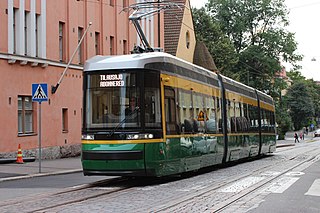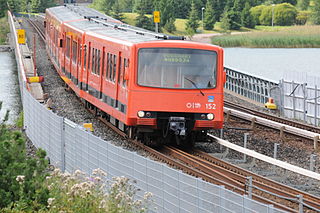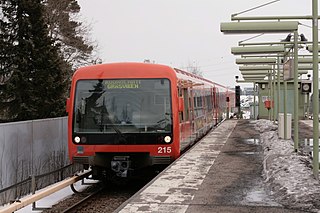
The Helsinki Metropolitan Area Council was a co-operation agency operating in the Helsinki metropolitan area, now replaced by HSL and HSY. The organisation had a few responsibilities, most notably regional public transport and waste management. It was subordinated to the city councils of the four participating cities. Furthermore, transport cooperation also included neighboring municipalities of Kerava and Kirkkonummi.

The Helsinki Metro is a rapid transit system serving the Helsinki capital region, Finland. It is the world's northernmost metro system. It was opened to the general public on 2 August 1982 after 27 years of planning. It is operated by Helsinki City Transport and Metropolitan Area Transport Ltd for Helsinki Regional Transport Authority and carries 92.6 million passengers per year.

Helsinki commuter rail is a commuter rail system serving the Helsinki metropolitan area. The system is managed by the Helsinki Regional Transport Authority (HSL) and operations are contracted out to VR at least until 2031.

Siilitie metro station is a ground-level station on the Helsinki Metro. It serves the northern part of the district of Herttoniemi in East Helsinki. There are 117 bicycle and 111 car parking spaces at the station. Both lines M1 and M2 serve Siilitie.

Länsimetro is an extension to the Helsinki Metro system in Finland, which opened on 18 November 2017. Länsimetro extends the system's two lines, M1 and M2, from Central Helsinki to the neighbouring city of Espoo. The new stretch continues the lines from the existing Ruoholahti station via the island of Lauttasaari, the Aalto University Otaniemi campus and Tapiola, the terminus of line M2. Line M1 continues further west to Matinkylä. Unlike previous extensions to the Helsinki Metro system, Länsimetro runs entirely underground. The second phase opened on 3 December 2022 and continues the line further west to Kivenlahti, near the municipal border of Kirkkonummi.

Trams in Helsinki form part of the public transport system organised by Helsinki Regional Transport Authority and operated by Metropolitan Area Transport Ltd in Finland's capital city of Helsinki. The trams are the main means of transport in the city center, and 56.8 million trips were made on the system in 2019. In addition to the older tram network, there is a single light rail line that was opened in October 2023. Although technically compatible with the tram network, the light rail line is separate from the city center tram network.

Public transport in Helsinki consists of bus, tram, metro, local railway and ferry services. The system is managed by the Helsinki Regional Transport Authority and covers Helsinki, Espoo, Kauniainen, Vantaa and the outlying Kerava, Kirkkonummi, Sipoo and Tuusula.

Jätkäsaari is a peninsula and a quarter in Helsinki, the capital city of Finland. It is part to the Kampinmalmi district and Länsisatama neighbourhood. It was the site of the main container port in Helsinki until late 2008, when the harbour moved to the new facilities in Vuosaari. The terminals for passenger ferries to Tallinn and Saint Petersburg remain in Jätkäsaari at the West Harbour.

The Helsinki Regional Transport Authority is the inter-municipal authority that maintains the public transportation network of the nine municipalities of Greater Helsinki, Finland.

Artic, styled as ARTIC or ForCity Smart, is an articulated low-floor tram model designed and manufactured by Škoda Transtech Oy in Finland. Trams of the design are in operation in Finland, Germany and Czechia, with further large orders in these countries. The design was subsequently rebranded under the Škoda ForCity brand.

Until 2021, Helsinki was Finland's only remaining city with tram traffic. Two other cities—Turku (see Turku tram) and Vyborg —have had tram systems. Vyborg abandoned its trams in 1957 after it was ceded to the Soviet Union after the end of World War II. Turku withdrew its trams in 1972.
The city of Helsinki and the neighbouring city of Vantaa have plans for a radical expansion of the Helsinki tram network within the 2020s and 2030s that would more than double the length of the network from 2021. If completed, the plans would both extend the current tram lines and build new light rail lines.

Helsinki City Bikes is a public bicycle system in Helsinki and Espoo and integrating with the rest of the public transport in Helsinki since May 2016. It is operated as a public-private partnership between Helsinki Regional Transport Authority (HSL), Helsinki City Transport (HKL), Espoo Technical and Environment Services, Moventia and Smoove.

Helsinki light rail line 15 is a 25-kilometre (16 mi) light rail line connecting Keilaniemi in Espoo and Itäkeskus in Helsinki, Finland. Known during construction as Jokeri light rail, construction was started in June 2019 and the line began operating in October 2023, about 10 months ahead of the original schedule. The line replaced the trunk bus line 550, the busiest bus service on the Helsinki Regional Transport Authority public transport network, at the end of 2023.

The HKL Class M100 is the first and oldest class of metro trains in use on the Helsinki Metro. One train consists of two individually numbered cars. A total of 42 units were manufactured between 1977 and 1984.

The HKL Class M200 is a class of metro trains in use on the Helsinki Metro, based on the DBAG Class 481 trains used on the Berlin S-Bahn. One train consists of two individually numbered cars. A total of 12 pairs were manufactured by Bombardier-DWA in Germany during 2000–2001.

The HKL Class M300 is a class of metro trains operated by Metropolitan Area Transport Ltd in use on the Helsinki Metro. 20 four-carriage trains were built between 2014 and 2016 by Construcciones y Auxiliar de Ferrocarriles for the Länsimetro extension. In November 2019, HKL announced the purchase of five additional trains, delivered in 2022.

Local and regional bus services are a large part of public transport in the Helsinki region. HSL bus services include internal services in Helsinki, Espoo, Kauniainen, Vantaa, Kerava, Kirkkonummi, Sipoo, Siuntio and Tuusula and regional services between them.
Metropolitan Area Transport Ltd is a Finnish city-owned transportation company responsible for operating the Helsinki tram network and parts of the Helsinki Metro for the Helsinki Regional Transport Authority. Its subsidiary Suomenlinnan Liikenne Oy operates the Suomenlinna ferry.

















